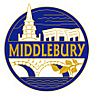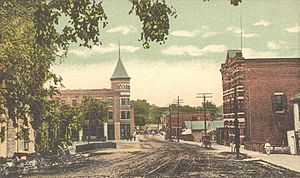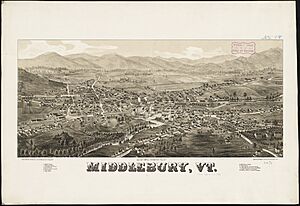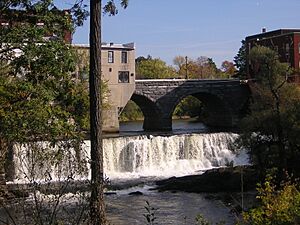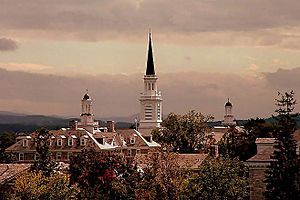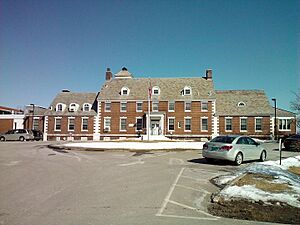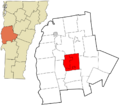Middlebury, Vermont facts for kids
Quick facts for kids
Middlebury
|
||
|---|---|---|
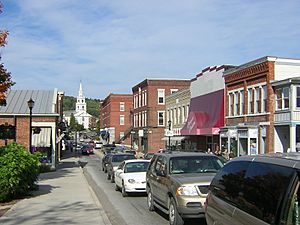
Main Street
|
||
|
||
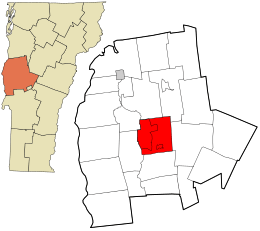
Location in Addison County and the state of Vermont
|
||
| Country | United States | |
| State | Vermont | |
| County | Addison | |
| Chartered | 1761 | |
| Communities | Middlebury East Middlebury Farmingdale |
|
| Area | ||
| • Total | 39.2 sq mi (101.6 km2) | |
| • Land | 38.8 sq mi (100.6 km2) | |
| • Water | 0.4 sq mi (1.0 km2) | |
| Elevation | 427 ft (130 m) | |
| Population
(2020)
|
||
| • Total | 9,152 | |
| • Density | 233.30/sq mi (90.08/km2) | |
| Time zone | UTC-5 (Eastern (EST)) | |
| • Summer (DST) | UTC-4 (EDT) | |
| ZIP Code |
05753
|
|
| Area code(s) | 802 | |
| FIPS code | 50-44350 | |
| GNIS feature ID | 1462146 | |
Middlebury is a town in Vermont, United States. It is the main town, also called the "shire town" or county seat, of Addison County, Vermont. In 2020, about 9,152 people lived there. Middlebury is famous for being home to Middlebury College. It also has the Henry Sheldon Museum of Vermont History, which teaches about the area's past.
Contents
History of Middlebury
Middlebury was officially started on November 2, 1761. This happened when Governor Benning Wentworth gave permission for the town to be built. Its name, "Middlebury," came from its location. It was in the middle of two other towns, Salisbury and New Haven.
Early Settlers and Challenges
The first settlers arrived in Middlebury in 1766, after the French and Indian Wars ended. John Chipman was one of the first to clear land for farming. However, during the American Revolutionary War, much of the town was burned in 1778. After the war ended in 1783, people returned to rebuild their homes. They cleared forests and started farms, growing crops like grains and hay.
Growth and Industry
Landowners wanted the town center to be on their property. Gamaliel Painter helped develop the village center near the Otter Creek falls. Many mills were built around these falls. These mills helped create different industries. There were factories for cotton, paper, and wool. There were also sawmills, gristmills, and places to make iron and cut marble.
In 1849, the Rutland and Burlington Railroad arrived in Middlebury. This helped the town grow even more. Around 1830, Middlebury was the second-largest town in all of Vermont.
Middlebury College and Other Events
Middlebury College was founded in 1800. It is a well-known college that focuses on liberal arts. Every summer, the college hosts special language schools. It also has the Bread Loaf Writers' Conference, which is a very old writing event.
In 2007, part of Middlebury was evacuated for a short time. This happened because a train went off its tracks.
Middlebury Today
Today, Middlebury is the biggest town in Addison County by population. It is an important center for business and shopping. The downtown area has a movie theater, a post office, and many shops and restaurants. There are also supermarkets and fast-food places along U.S. Route 7. Middlebury has Vermont's only remaining A&W car-hop restaurant. It is a popular spot for both locals and college students.
Geography and Climate
Middlebury is located in the middle of Addison County in western Vermont. The Otter Creek flows through the town from south to north. The Middlebury River also flows into Otter Creek. Chipman Hill, a large hill, rises about 450 feet above the village. The Green Mountains are to the east, and the Champlain Valley is to the west.
Area and Water
The town covers about 101.6 square kilometers (39.2 square miles). Most of this area, about 100.6 square kilometers (38.8 square miles), is land. The rest, about 1.0 square kilometer (0.4 square miles), is water.
Roads and Nearby Towns
Several main roads cross Middlebury, including U.S. Route 7 and Vermont Route 30. The town is next to New Haven and Bristol to the north. Ripton is to the east, and Cornwall and Weybridge are to the west. Salisbury is to the south. In 2010, a new bridge opened over Otter Creek. This bridge helps reduce traffic in downtown Middlebury. The village of East Middlebury is also part of the town.
Weather in Middlebury
Middlebury has a humid continental climate. This means it has big changes in temperature throughout the year. Summers are warm to hot and often humid. Winters are cold, sometimes very cold.
Population and People
| Historical population | |||
|---|---|---|---|
| Census | Pop. | %± | |
| 1790 | 395 | — | |
| 1800 | 1,263 | 219.7% | |
| 1810 | 2,138 | 69.3% | |
| 1820 | 2,535 | 18.6% | |
| 1830 | 3,468 | 36.8% | |
| 1840 | 3,162 | −8.8% | |
| 1850 | 3,517 | 11.2% | |
| 1860 | 2,879 | −18.1% | |
| 1870 | 3,086 | 7.2% | |
| 1880 | 2,993 | −3.0% | |
| 1890 | 2,793 | −6.7% | |
| 1900 | 3,045 | 9.0% | |
| 1910 | 2,848 | −6.5% | |
| 1920 | 2,914 | 2.3% | |
| 1930 | 2,968 | 1.9% | |
| 1940 | 3,175 | 7.0% | |
| 1950 | 4,778 | 50.5% | |
| 1960 | 5,305 | 11.0% | |
| 1970 | 6,532 | 23.1% | |
| 1980 | 7,574 | 16.0% | |
| 1990 | 8,034 | 6.1% | |
| 2000 | 8,183 | 1.9% | |
| 2010 | 8,496 | 3.8% | |
| 2020 | 9,152 | 7.7% | |
| U.S. Decennial Census | |||
In 2010, there were 8,494 people living in Middlebury. There were 2,860 households, which are groups of people living together. The population density was about 209.7 people per square mile.
Most of the people in Middlebury were White (90.3%). There were also people of Asian (4.3%), Hispanic or Latino (3.0%), and Black or African American (1.3%) backgrounds.
About 17.5% of the population was under 18 years old. A large group, 31.4%, was between 18 and 24 years old. The average age in Middlebury was 27 years.
The average income for a household in Middlebury was $37,723. For families, the average income was $46,691. About 9.6% of the people in Middlebury lived below the poverty line.
Things to See and Do
Middlebury has several interesting places to visit:
- Emma Willard Memorial: A place honoring Emma Willard, who was important for women's education.
- Henry Sheldon Museum of Vermont History: Learn about Vermont's history here.
- Ilsley Public Library: The town's public library.
- Middlebury to Her Soldiers (sculpture): A sculpture dedicated to soldiers.
- TAM – Trail Around Middlebury: A trail for walking and enjoying nature.
Education in Middlebury
Middlebury has schools for all ages, from elementary to college.
Public Schools
- Mary Hogan Elementary: For students in Pre-K through 5th grade.
- Middlebury Union Middle School: For students in 6th through 8th grade.
- Middlebury Union High School: For students in 9th through 12th grade.
- P.A. Hannaford Career Center: A technical center for high school students and adults.
Private Schools
- The Aurora School: A private school for Pre-K students.
- Bridge School: A private elementary school.
Higher Education
- Community College of Vermont: Has a campus in Middlebury.
- Middlebury College: A well-known four-year college.
Town Services and Transportation
Medical Care
Porter Medical Center provides medical care for Middlebury and the surrounding communities.
Transportation Options
Air Travel
Middlebury State Airport is located east of town. It is used for private planes.
Bus Services
Bus service in Middlebury is provided by Tri Valley Transit. You can also find intercity bus lines that connect Middlebury to other cities.
Major Roads
- U.S. Route 7: This is the main north-south highway through Middlebury.
- Vermont Route 23: This road goes through the college campus.
- Vermont Route 30: This road connects to Route 7 in town.
- Vermont Route 116: This road is on the east side of town.
- Vermont Route 125: This road goes through Middlebury College and then east out of town.
Train Service
Amtrak's Ethan Allen Express train serves the station in Middlebury. This train connects Middlebury to Burlington in the north and New York City in the south. Train service started in Middlebury in July 2022.
Notable People from Middlebury
Many interesting people have connections to Middlebury:
- Julia Alvarez: A famous author.
- John Deere: The inventor and manufacturer known for his farming equipment.
- Jim Douglas: The 80th governor of Vermont.
- Robert Frost: A very famous poet.
- Bill McKibben: An author and environmentalist.
- Emma Willard: A strong supporter of women's rights and a school founder.
Images for kids
See also
 In Spanish: Middlebury (Vermont) para niños
In Spanish: Middlebury (Vermont) para niños


